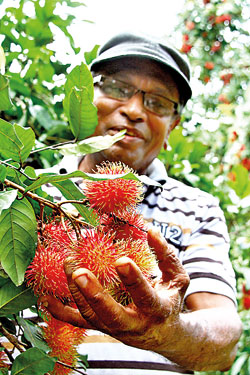A tasteful colonial heritage

A bountiful harvest: A wheelbarrow full of plucked luscious fruit
Eranga Kumara and his peni rambutan of Malwana are a familiar sight at the Gaspaha junction off Dam Street, Colombo during the rambutan season, for he has been coming there for the past 20 years. Gone are the days though when a rambutan was just 25 cents. “Ada polathuru koodath ne,” (today baskets made out of thatched coconut leaves in which rambutan was transported are obsolete) laments Eranga while loading his tuk-tuk with the seasonal fruit too tempting to resist. “Those days for an entire basket, we paid the tree owners around Rs 150 to 200,” reflects the seller who points out that this system is now long gone and a ‘wholesale price’ per fruit is now agreed upon. The traditional pol athu baskets are today replaced with plastic ware.
The recent catastrophic floods have not spared Malwana- both the cultivator and the rambutan seller had been at the nature’s mercy, Eranga sighs. But the unprecedented climatic changes have made the trees ‘tenacious’, says Sarath Kumara Hapuarachchi, a proprietor of a substantial rambutan cultivation of nearly 75 trees in Malwana. “Today the traditional flowering season of March-April and the harvesting season of June-August have been challenged due to climate change. So much so in certain years, we have been experiencing an unexpected harvest at odd times of the year.”
The rambutan, Nephelium lappaceum is in the family ‘Sapindaceae’ native to the Malay-Indonesian region and other regions of tropical Southeast Asia. It is believed that rambutan is part of our colonial legacy, the Dutch having introduced the fruit from their Southeast Asian colonies to other parts. As Mr. Hapuarachchi, a retired Education Inspector explains, Malwana became the

An expert on rambutan: Sarath Kumara Hapuarachchi
local rambutan hub due to the Dutch influence in the area. “The Dutch wielded considerable power in Malwana, having put up a fort here as well. The rich soil of Kelani river valley and other climatic conditions conducive to their growth are also assumed to have led the Dutch to first introduce the fruit to Malwana,” he notes. Although Malwana varieties are considered to be the premier quality fruit, some off-season crops are also found in areas such as Bibile and Monaragala.
Predominantly grown in home gardens, the naturally pollinated trees grow to considerable heights while specially cloned varieties which the cultivators obtain from state- approved nurseries are smaller. “What is commercially available along the waysides is the latter, which is superior in texture and taste. This again comes in red and yellow and the demand for the red variety is more.”
Some rambutan land owners ‘lease out’ their trees to middle men, while others deal direct with the buyers. As Mr. Hapuarachchi points out, leasing could be a risky affair for the lessee in the event of a natural catastrophe which could result in a profit loss. Interestingly, the quality of the fruit sometimes differs from tree to tree even in case of commercially grown trees, explains the land owner who employs his own ‘seasonal hands’ on his land for plucking.
For a rambutan tree to flower, it takes around three to four years, says Mr. Hapuarachchi who says the tree requires nitrogen-rich fertilizer.“Chicken manure fertilizer is the most commonly used form which is a rich source of nitrogen.”

Laden with fruit: Rambutan trees at Malwana. Pix by Indika Handuwala
Customs and rituals also surround this much loved fruit, most of which are fast eroding today. Although many cultivators still make special vows at the Nawagamuwa Devale for a bumper crop, kemkrama(special chanting and anointing) are almost obsolete.“However, the buyers are still reluctant to pluck their fruits off trees which are partially harvested by another, preferring a fresh tree,” says the cultivator.
Rambutan dosi a one-time sought after delicacy commonly prepared at Malwana households during the season is less common today. “With the increased incidence of diabetes, the demand for this delicacy is not so great,” smiles Mr. Hapuarachchi, adding that the demand for canned rambutan in the export market however is quite high. “The advanced research pertaining to the fruit including gene technology as found in Malaysia is still not locally exploited,” he says.
A mature rambutan tree could yield about 5000 fruits per season according to Mr. Hapuarachchi. Once the life span of a tree which is about 40 years is over, it is an ideal source of timber for supportive beams of roofs, he adds.
They are hard to resist but this is a fruit which deceives the gut, as it doesn’t ‘fill in’ as most other fruits do, warn Malwana folks. Indeed one could get easily carried away with their fleshy pulp until sore throats and red eyes hit you the next day!


